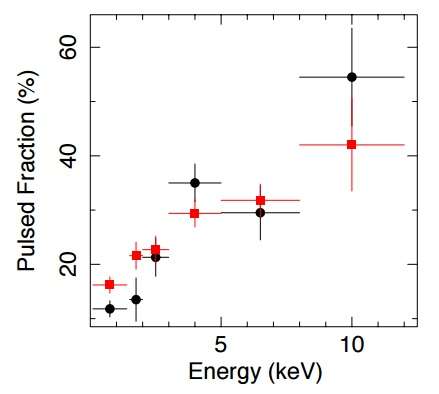September 26, 2016 report
Pulsar discovered in an ultraluminous X-ray source

(Phys.org)—A team of European astronomers has discovered a new pulsar in a variable ultraluminous X-ray source (ULX) known as NGC 7793 P13. The newly found object is the third ultraluminous X-ray pulsar detected so far, and also the fastest-spinning one. The findings are detailed in a paper published Sept. 21 in the arXiv pre-print server.
ULXs are point sources in the sky that are so bright in X-rays that each emits more radiation than a million suns emit at all wavelengths. Although they are less luminous than active galactic nuclei, they are more consistently luminous than any known stellar process.
NGC 7793 P13 (also known as XMMU J235751.1–323725) is located in the spiral galaxy NGC 7793 in the Sculptor constellation, about 12.7 million light years from the Earth. According to a new study, which was conducted by a team of researchers led by Gianluca Israel of the Astronomical Observatory of Roma, Italy, this ULX hosts a 0.42-second pulsar.
"Here, we report on the discovery of coherent pulsations at a period of 0.42 s in the EPIC pn lightcurves of XMMU J235751.1–323725," the team wrote in the paper.
The pulsar was detected as part of the X-ray Transient and variable Sky (EXTraS) project aimed at exploring and disclosing the serendipitous content provided by the European Photon Imaging Camera (EPIC) onboard ESA's XMM-Newton spacecraft. Israel's team searched for coherent periodic signals among about 290,000 time series of sources in all EPIC public data with more than 50 counts that had been detected by XMM-Newton.
"The discovery is the result of a large effort during which we applied, in an automatic fashion, advanced timing tools to study about a half-million X-ray light curves extracted from the EPIC instruments on board of XMM-Newton. Such light curves were searched for coherent signals testifying to the presence of a cosmic clocks—mainly spinning neutron stars and white dwarfs. We spent several months in order to set up and check a pipeline able to handle the huge amount of data, to carry out the blind search, and to classify the outcomes. It was challenging but worth doing it," Israel told Phys.org.
The scientists found that the newly discovered pulsar is a binary system hosting an accreting neutron star with a mass of approximately 1.4 solar masses and a massive companion star of about 20 solar masses. It is very likely that the orbital period of the system is about 63 days, even though the optical modulation might also be related to a super-orbital period sometimes observed in ULXs.
The researchers also noted that the luminosity of the neutron star is extremely high. The star is accreting at super-Eddington rates, where the Eddington luminosity sets an upper limit on the accretion luminosity of a compact object—above such luminosity, accretion is halted by the radiation pressure. The maximum Eddington luminosity is about 100 fainter than that observed in NGC 7793 P13.
"The first implications we can infer from this discovery is that the traditional spectral method used to classify ULX objects is not unambiguous. Correspondingly, we believe that other accreting neutron stars are likely hidden in the known sample of ULX. Additionally, it is evident that the standard accretion models fail to account for the pulsar X-ray luminosity," Israel said.
He concluded that further studies of the new pulsar, both in the X-rays and in the optical/infrared bands, will allow his team to firmly establish the nature of the ~63-day modulation (orbital versus super-orbital) and the way the pulsar properties are evolving as a function of time and flux.
More information: Discovery of a 0.42-s pulsar in NGC 7793 P13, arXiv:1609.06538 [astro-ph.HE] arxiv.org/abs/1609.06538
Abstract
NGC 7793 P13 is a variable (luminosity range > 1000) ultraluminous X-ray source (ULX) proposed to host a stellar-mass black hole of less than 15 M⊙ in a binary system with orbital period of 64 d and a 18-23 M⊙ B9Ia companion. Within the EXTraS project we discovered pulsations at a period of ~0.42 s in two XMM-Newton observations of NGC 7793 P13, during which the source was detected at LX∼2.1×1039 and 5×1039 erg s−1 (0.3-10 keV band). These findings unambiguously demonstrate that the compact object in NGC 7793 P13 is a neutron star accreting at super-Eddington rates. While standard accretion models fail to account for the pulsar X-ray luminosity, the presence of a multipolar magnetic field with B ~ few × 1013 G close to the base of the accretion column appears to be in agreement with the properties of the system.
© 2016 Phys.org



















